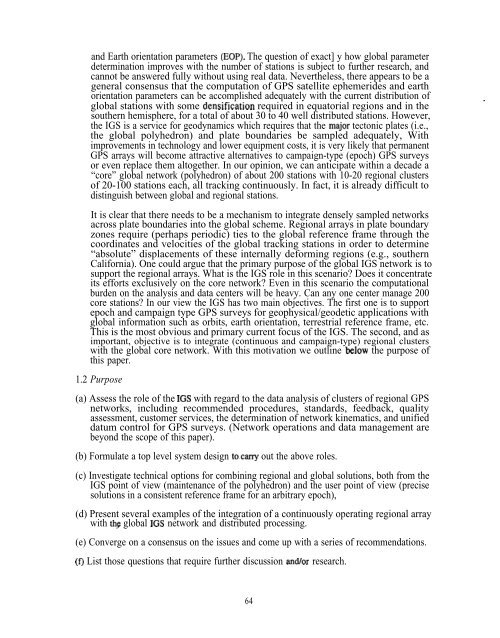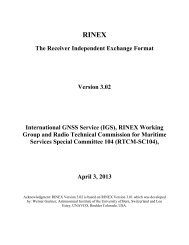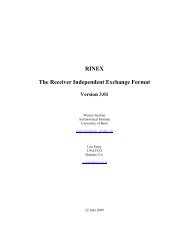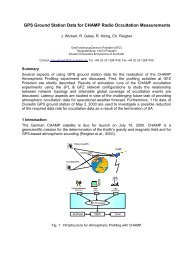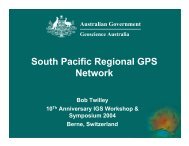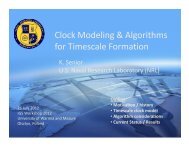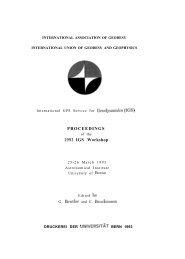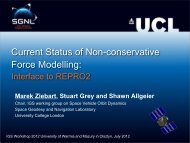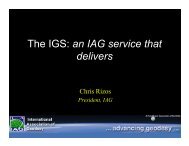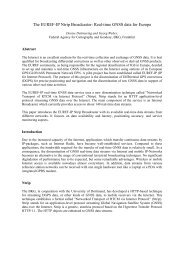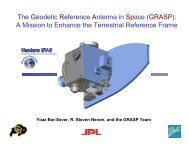operation. Likewise, Japanese government agencies are establishing a permanent, 60station crustal deformation monitoring network in the Kanto plain and an active controlnetwork of over 100 stations across the entire Japanese archipelago. At the presenttime, the analysis centers use about 20 to 40 stations in their routine solutions. Dataprocessing time is at best proportional to the square of the number of observingstations, so a 90 station network takes an order of magnitude more time to process thana 30 station network, Computer memory limitations present a similar problem.Fortunately, there is little reason to process a 90 station network simultaneously.There are a number of strategies that can reduce processing time by an order ofmagnitude without compromising regional positioning accuracy.(b) Increased involvement %At present, there are seven analysis centers producing globalsolutions, with little need for more. As the number of stations increases around theworld, new analysis centers can make a considerable contribution by focusing theirattention on regional clusters, which they can monitor efficiently for problems. Singleproblematic stations might go unnoticed or ignored by those groups who are primarilyinterested in global parameters. A regional analysis center will have more of a vestedinterest in the performance of the regional cluster. It will also help ensure that the“polyhedron” does not remain that of -40 core sites used in the global processing, butthat it include data consistently from, perhaps, hundreds of new permanent sites. Theregional analysis center can also serve a dual function in providing assistance to usersperforming GPS surveys, and validating the resulting products. Needless to say, moreinvolvement will also lead to a broader base of expertise and knowledge from which<strong>IGS</strong> can draw the best ideas and solutions to problems.(C) Standardization and conslstencv . The recent trend to more stations is accelerating, withno reason to believe that it will slow down. The analysis of GPS data iscomputationally intensive so that it is not practical to reprocess all available data manytimes as is done with VLBI data, for example. Recognizing this, it is imperative thatthe routine data reduction of tomorrow’s blossoming regional networks be done in amutually consistent, acceptable, and archivable way. Without adequate preparation andorganization, we may effectively lose a golden opportunity for unifying the world’sGPS networks. It is assumed that there is no problem finding willing analysis centers(regional networks are not installed without some plan for analysis!). <strong>IGS</strong> can facilitatea consensus on a set of standards so that a required level of consistency and efficiencyis realized. Given the benefits that regional network users will get in return (consistentreference frame, consistent orbits, expert information, etc.), it is likely that regionalanalysis groups will cooperate and abide by a reasonable set of standards.(d) ~nhancinz the “Service” in <strong>IGS</strong>. Until now, <strong>IGS</strong> global analysis centers have beenpreoccupied with the technical details and practical aspects that are necessary to deliverthe products. There now needs to be more focus on servicing our customers (ofcourse, we the participants are customers too). The current status is that customershave little guidance on using the routine <strong>IGS</strong> global products for regional networkgeodesy, and there is no formal way to feedback, the regional solutions into the globalreference frame. Any customers who want to get the highest levels of precision fortheir regional networks ought to be given explicit recommendations on how to proceed,and <strong>IGS</strong> should provide the means to make the procedure as simple as possible withoutsignific~tly compromising regional accuracy. <strong>IGS</strong> should also specify the proceduresby which the regional centers may submit their network solutions back to <strong>IGS</strong> (asemphasized above in point 1.2(c)).(e) )lef n“nz the Role of IG& At some point, increasing the number of stations in theglo~dl network will produce negligible improvement in the accuracy of estimated orbits63
and Earth orientation parameters (EOP), The question of exact] y how global parameterdetermination improves with the number of stations is subject to further research, andcannot be answered fully without using real data. Nevertheless, there appears to be ageneral consensus that the computation of GPS satellite ephemerides and earthorientation parameters can be accomplished adequately with the current distribution ofglobal stations with some densification required in equatorial regions and in thesouthern hemisphere, for a total of about 30 to 40 well distributed stations. However,the <strong>IGS</strong> is a service for geodynamics which requires that the major tectonic plates (i.e.,the global polyhedron) and plate boundaries be sampled adequately, Withimprovements in technology and lower equipment costs, it is very likely that permanentGPS arrays will become attractive alternatives to campaign-type (epoch) GPS surveysor even replace them altogether. In our opinion, we can anticipate within a decade a“core” global network (polyhedron) of about 200 stations with 10-20 regional clustersof 20-100 stations each, all tracking continuously. In fact, it is already difficult todistinguish between global and regional stations.It is clear that there needs to be a mechanism to integrate densely sampled networksacross plate boundaries into the global scheme. Regional arrays in plate boundaryzones require (perhaps periodic) ties to the global reference frame through thecoordinates and velocities of the global tracking stations in order to determine“absolute” displacements of these internally deforming regions (e.g., southernCalifornia). One could argue that the primary purpose of the global <strong>IGS</strong> network is tosupport the regional arrays. What is the <strong>IGS</strong> role in this scenario? Does it concentrateits efforts exclusively on the core network? Even in this scenario the computationalburden on the analysis and data centers will be heavy. Can any one center manage 200core stations? In our view the <strong>IGS</strong> has two main objectives. The first one is to supportepoch and campaign type GPS surveys for geophysical/geodetic applications withglobal information such as orbits, earth orientation, terrestrial reference frame, etc.This is the most obvious and primary current focus of the <strong>IGS</strong>. The second, and asimportant, objective is to integrate (continuous and campaign-type) regional clusterswith the global core network. With this motivation we outline below the purpose ofthis paper.1.2 Purpose(a) Assess the role of the <strong>IGS</strong> with regard to the data analysis of clusters of regional GPSnetworks, including recommended procedures, standards, feedback, qualityassessment, customer services, the determination of network kinematics, and unifieddatum control for GPS surveys. (Network operations and data management arebeyond the scope of this paper).(b) Formulate a top level system design tocarry out the above roles.(c) Investigate technical options for combining regional and global solutions, both from the<strong>IGS</strong> point of view (maintenance of the polyhedron) and the user point of view (precisesolutions in a consistent reference frame for an arbitrary epoch),(d) Present several examples of the integration of a continuously operating regional arraywith thp global <strong>IGS</strong> network and distributed processing.(e) Converge on a consensus on the issues and come up with a series of recommendations.(~ List those questions that require further discussion and/or research.64
- Page 1 and 2:
●INTERNATIONAL ASSOCIATION OF GEO
- Page 3 and 4:
TABLE OF CONTENTS.FINAL AGENDA . .
- Page 5 and 6:
13:30 NGS14:00 S1014:30 EMR15:00 CO
- Page 7 and 8:
LIST OF PARTICIPANTS:Prof. Gerhard
- Page 10 and 11:
Table 1. Current IGS Analysis Cente
- Page 12 and 13:
The first field identifies the reco
- Page 14 and 15:
Summary InformationThe third produc
- Page 16 and 17: From Figure 1 we find that there ar
- Page 18: to define a reference clock in thei
- Page 22 and 23: SESSION 2(IGS orbit products)
- Page 24 and 25: 1. introductionThe main objectives
- Page 26 and 27: ecause of the above averaging. This
- Page 28 and 29: RMS per center (m)o 0 0 0 0 0 oA0Iv
- Page 30: Scale (ppb)I I I I I 11+-b~ul0Amo&I
- Page 33 and 34: and NGS. Note that the day to day v
- Page 35 and 36: Rotation around X-axis (mas)1&0 0o
- Page 37 and 38: discussed in Section 3 are here see
- Page 39 and 40: -----------------------------------
- Page 41 and 42: Residuals in Meters1 1 1 1 1 1 1=%m
- Page 43 and 44: Residuals inMeters11111cnficJJw-o A
- Page 45 and 46: I I I—Residuals in Meters..—.
- Page 47 and 48: 1111ResidualsMeters,—{44
- Page 49 and 50: Residuals in MetersI I I II I I IIc
- Page 51 and 52: Rms in MetersI 1 ! I 1 10 n0 a0n.ff
- Page 53 and 54: IGS- and the COM-sets, but that the
- Page 55 and 56: Table 4.1 N.A. Baseline Repeatabili
- Page 57 and 58: ..Figure 5.1:Clock solutions for FA
- Page 59 and 60: specifically the preanalysis can be
- Page 61 and 62: discussion, a question as to whethe
- Page 63 and 64: SUMMARY OF SESSION 3This Session be
- Page 65: IGS POSITION PAPER, IGS ANALYSIS CE
- Page 69 and 70: LbPIERS and IGSCentral Bureausand D
- Page 71 and 72: @ IGS will develop instructions, an
- Page 73: 2.2 Analysis Center System DesignFi
- Page 76 and 77: applied to the solution in order to
- Page 78 and 79: ..standard deviations. This is conv
- Page 80 and 81: known, the two solutions will be ad
- Page 82 and 83: errors, and can therefore be used a
- Page 84 and 85: International Terrestrial Reference
- Page 86 and 87: Thus, there is the potential of fee
- Page 88 and 89: 90” 100” 110” 120” 130” 1
- Page 91 and 92: adiation parameters for each satell
- Page 93 and 94: Bock, Y., R.I. Abbot, C.C. Counselm
- Page 95 and 96: SUMMARY OF SESSION 4This session st
- Page 97 and 98: INTERNATIONAL EARTH ROTATION SERVIC
- Page 99 and 100: x- differences with IERS0.001”I I
- Page 101 and 102: SUMMARY OF SESSION 5In the last ses
- Page 103 and 104: 1) I(X3 PROCESSING/REPORTS/FORMATSS
- Page 105 and 106: IGS should foster and encourage reg
- Page 107 and 108: ..INTERNATIONAL GPS SERVICE FORGEOD
- Page 109 and 110: ortL.s.4
- Page 111 and 112: 1234567a91011121314IsIt17ItIs2C2122
- Page 113 and 114: . Ruth Neilan16S Central BureauJet
- Page 115 and 116: ON1T.>● Jim ZumbergeJet Propulsio
- Page 117:
PROPOSED ORGANIZATION OF THE INTERN


